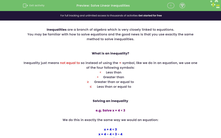Inequalities are a branch of algebra which is very closely linked to equations.
You may be familiar with how to solve equations and the good news is that you use exactly the same method to solve inequalities.
What is an inequality?
Inequality just means not equal to so instead of using the = symbol, like we do in an equation, we use one of the four following symbols:
< Less than
> Greater than
≥ Greater than or equal to
≤ Less than or equal to
Solving an inequality
e.g. Solve x + 4 < 3
We do this in exactly the same way we would an equation:
x + 4 < 3
x + 4 - 4 < 3 - 4
x < -1
What this means is that if you put any number that is less than -1 (-2, -3, -4, etc.) into the original equation, it will be true.
e.g. Solve x/2 > 7
Again, we do this in exactly the same way we would an equation:
x/2 > 7
x/2 × 2 > 7 × 2
x > 14
The special case
There is one special case that we need to be aware of and on the lookout for.
Let's look at an example to illustrate this point:
5 < x + 3
5 - 3 < x + 3 - 3
2 < x
The issue here is that the x is on the right.
If this was an equation, we would just swap them around but we cannot do this with an inequality.
The inequality currently means '2 is less than x' so if we want to get our x on the left, we would have to say 'x is greater than 2'.
So 2 < x is the same as x > 2.
The rule is: If you want to switch the sides of an inequality over, remember you have to swap the sign.
In this activity, we will solve inequalities where our variable will end up on both the right- and left-hand sides.
If it ends up on the right, we will need to flip our inequality over and swap our sign.








